Blog » How to Guides » HOW tO BECOME AN ANIMAL-ASSISTED THERAPIST: The Definitive Guide
HOW tO BECOME AN ANIMAL-ASSISTED THERAPIST
The Definitive Guide
Have you been thinking of Animal-Assisted Therapy, but don’t know where and how to begin?
Or aren’t fully convinced that Animal-Assisted Therapy can be a highly rewarding career?
You’ve come to the right place.

This is the one-stop guide for all you need to know about starting an Animal-Assisted Therapy coaching business.
So if you want to:
- Build a steady and lucrative career as an Animal-Assisted Therapist
- Have a continuous stream of clients without putting in too much effort
- Be in charge of your life, and in control of your earnings
- Combine your love for animals with an upcoming business stream
- Turn your passion into a business that does good in the world
Then this article is for you.
Let’s get started!
Don’t have time to read the whole guide right now?

No worries. Let me send you a copy so you can read it when it’s convenient for you. Just let me know where to send it (takes 5 seconds)
Yes! Give me my PDFContents
CHAPTER 1:
The Fundamental
We are lucky to exist in an era when mental health, as well as other kinds of disabilities, are slowly becoming destigmatized and starting to be openly discussed and addressed.
We, as a society, are moving towards being more accepting, and finding ways to make the lives of disabled people easier; to help them adapt to a society that is otherwise dominated by and geared towards those who are physically and mentally able.

So we are constantly finding ways to adapt various therapy techniques to make sure each person has a proven, yet unique, therapy method suited to their needs.
One of these therapy treatment methods is Animal-Assisted Therapy.
The reason successful therapists are able to combine their love for animals with a rewarding career is that they treat it like a business.
What does that mean?
Let me walk you through every step of the process, with examples of people who have made it big, to boot.
But before we get around to that, let’s make sure you have your fundamentals straight.
What is Animal-Assisted Therapy (or Pet Therapy)?
The first question you might have is, “What exactly is Animal-Assisted Therapy?”
Is it just sessions where people can play with animals, and pet them to feel calmer and happier?
Can you use your pet cat as a therapy animal? After all, she’s so loving and everyone who pets her feels so much calmer.
Well, not exactly. Yes — in part, Animal-Assisted Therapy (also known as Pet Therapy) uses animals, sometimes even pets, for therapy.
But, primarily, what makes it stand out is that animals are strictly used in goal-oriented treatment sessions.
These goals can range from physical to mental, and emotional to social. Each session has a predefined goal which the animals, along with the therapist, help the client achieve.
The animal, even if it is a pet, needs to be extensively trained before it can be used to assist in therapy.
The History of Animal-Assisted Therapy
So how did it all start?
The earliest records of animals being used for therapy date back to ancient Greece, where the Greeks used animals, especially horses, to help ease the pain and improve the mood of severely ill or injured people.
Initially, this practice was quite limited only to Greek homes, but eventually, the benefits started to spread; around the 1600s, people started using horses regularly to treat those who were ailing.
During the first and the second World Wars, doctors started using farm animals to treat veterans and to help ease the trauma and stress associated with the aftermath of war.
Surprisingly, in Belgium, the use of pet animals for the purpose of therapy was not explored until the Medieval Ages.
Even more interestingly — back then, using pets as therapy for humans was a two-way street, in the sense that humans were also used to treat pets who were experiencing the loss of their owner or other emotional trauma.
Isn’t that fascinating?
Being around people helped such pets regain their personality, and also helped humans in various kinds of emotional therapy.
This practice truly gained momentum in the 1800s and 1900s, when several psychotherapists, such as Florence Nightingale and Sigmund Freud, started conducting research on this topic.
Freud was also believed to use his pet puppy, Jofi, in many of his therapy sessions, since he believed that dogs were able to understand human emotional needs best.
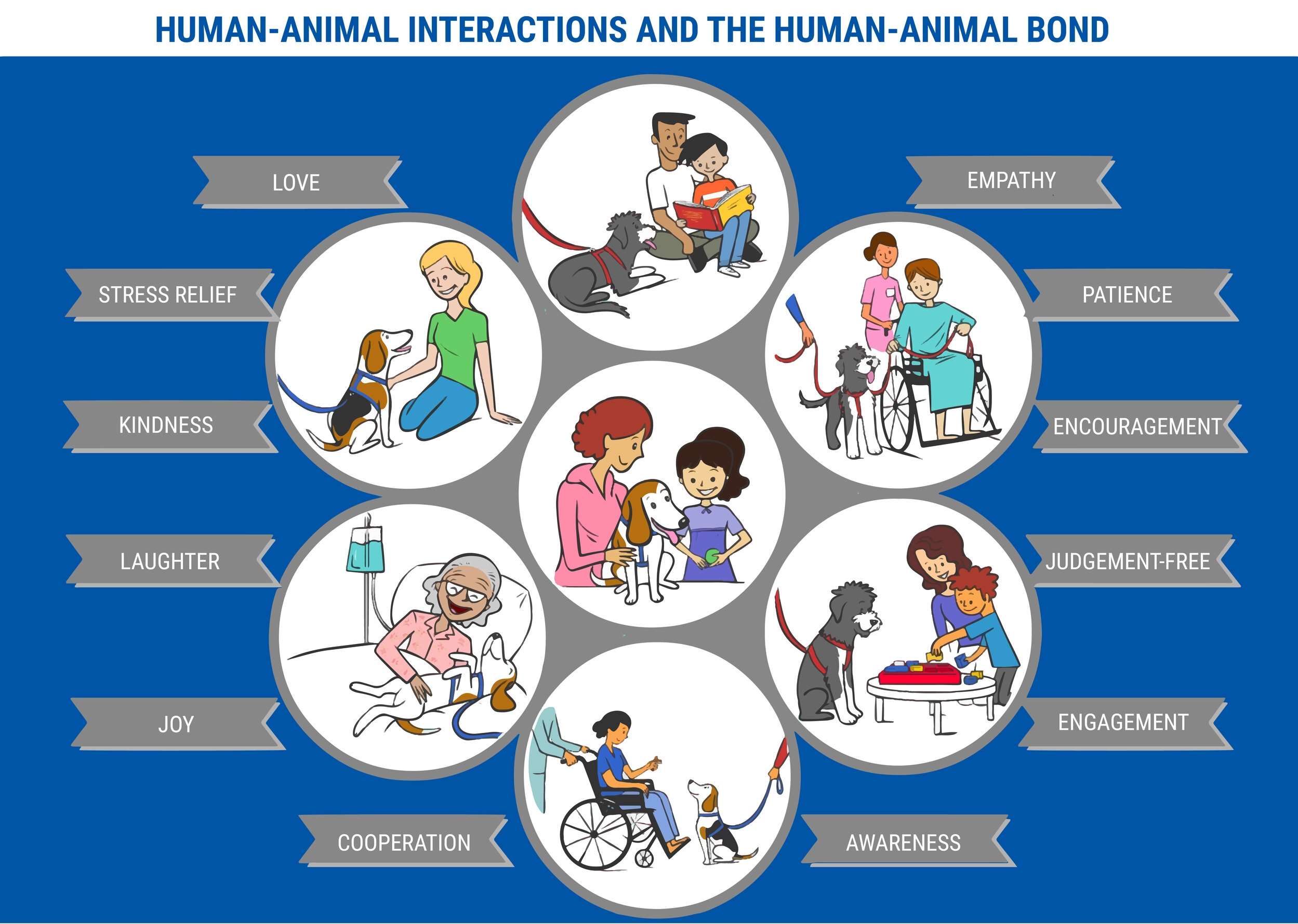
What does an Animal-Assisted Therapy session look like?
The answer to this lies in first identifying the individual needs of the client, and dividing those into small, achievable, and measurable goals.
These goals, of course, change according to the condition and the type of help a person needs.
Since Animal-Assisted Therapy can be used for both physical and emotional therapy, examples of therapy goals can include (but not remain limited to):
- Providing comfort and reducing levels of pain,
- Improving movement or motor skills, developing social or behavioral skills, increasing motivation toward activities such as exercise, interacting with others, etc.
Animal therapy in itself has two halves, as such; the handler and the animal. More often than not, the handler of the animal is the owner of the animal itself.
There are many institutions that train and certify handlers, as well as connect them to healthcare providers. The handler works closely with the doctor to help the client achieve the goals of therapy.
Before being certified and matched, the handler and the dog will have to pass various checks and certifications allowing them to work as therapy providers under doctors.
The handler’s coursework for the certification includes, but is not limited to, courses on how to interact with people, being professional, and the types of therapy they can provide, since not all animals can provide all kinds of therapy.
The animal also has to be verified and checked.
Most of the checks and certifications for animals include temperament testing as well as the ability to stay focused on the task at hand.
Additionally, the animal is rigorously checked for vaccination records and other tests, to verify that it is healthy and free of any diseases/disease-causing agents.
After these individual checks and certifications, the animal and the handler have to go through various checks and certifications as a pair.
These tests mainly include obedience training, safety checks, mock sessions, etc. This is to ensure that the pair is behaving in the most professional manner, and is not a health hazard for any or all parties involved.
This entire process is long but is extremely rewarding, as when one passes these checks and starts assisting therapy sessions, they truly understand the magnitude of the effect that Animal-Assisted Therapy can have on bettering clients’ lives.
What Animal-Assisted Therapy is Not
One of the most important things to understand during this process is the differences between what a therapy animal is and is not.
The most important difference is that a therapy animal is not a service animal. This means that therapy animals are not certified to enter places where animals are not allowed.
Therapy animals are allowed in places where regular pets are allowed, as well as in hospitals, schools, libraries, etc., which allow therapy animals.
Unlike service animals, therapy animals are not allowed in business institutions; these include hotels, cinemas, theatres, etc.
In a sense, therapy animals are closer to being treated as pets, when it comes to entry into public places.
Another thing to remember is that a therapy animal is always supposed to be accompanied by its handler.
Since not all clients are handlers of the therapy animal, they will see the animal only during sessions.
Essentially, it means that the client may not have access to the therapy animal at all times, unlike service animals.
Just like service animals, therapy animals have restrictions too (albeit far fewer) about who can pet them and how and where they can be petted.
Remember — therapy animals are at work, and so, just like it is incorrect to disturb a person at work, it is incorrect to disturb a therapy animal at work by petting it or distracting it in other ways.
Some Famous Therapy Animals Around the World
One of the most famous examples of a therapy animal is Oscar the cat.
Oscar gained fame in 2007 in the US and abroad for his uncanny ability to predict death in terminally ill patients.
He was known for cuddling the patients and helping calm them down till they passed away, after which he would quietly leave the room.
Another famous therapy animal was Spartacus.
He was the first on scene at the Sandy Hook Elementary School shooting in 2012 in the US.
He was able to provide comfort for the traumatised students, teachers, and first responders for months.
The US also passed a law after this incident which now makes it possible for the victims/survivors to have access to therapy animals within 24 hours of the incident.
One more curious example of a therapy animal is Buttercup, the pot-bellied pig. She helps autistic children improve their social skills, and — in one heartwarming incident — one severely autistic boy even spoke to his classmates for the first time after stroking Buttercup.
Chapter 2:
Benefits and Uses of Animal-Assisted Therapy
Now that we have all the basics straight, let’s dive deeper into some of the nitty gritties of Animal-Assisted Therapy.
I mentioned earlier that Animal-Assisted Therapy is used to assist in relieving conditions associated with both physical and mental health.
But what are the exact benefits of using this type of therapy for each aspect?
Let’s get straight to it.

For Mental Health
Many studies have found that Animal-Assisted Therapy helps the most with mental health issues characterised by typical markers such as stress and anxiety. That is why Animal-Assisted Therapy is so beneficial in:
- Decreasing anxiety and stress
- Decreasing perceptions of pain
- Reducing feelings of fear or worry
- Increasing feelings of social support
- Providing motivation, stimulation, and focus
These markers are typically noticed in people with anxiety and depression. But they are also seen in a few outliers depending on age.
Since Animal-Assisted Therapy is helpful in assisting with therapy across various ages, studies have shown that it is extremely helpful in aiding with:
- Dementia
- Depression
- Anxiety
- Autism spectrum disorder
- Attention Deficit Hyperactivity Disorder (ADHD)
- Schizophrenia
Autism societies across the world use therapy horses to assist people with autism and Down Syndrome. These sessions have shown to be effective in alleviating day-to-day hardships for many people.
Therapy horses, as well as therapy dogs, have been proven to help with the symptoms of post-traumatic stress disorder (PTSD), usually observed in war veterans.
Some people going through rehabilitation for substance abuse also respond well, and have a greater sense of well-being, when working with an animal.
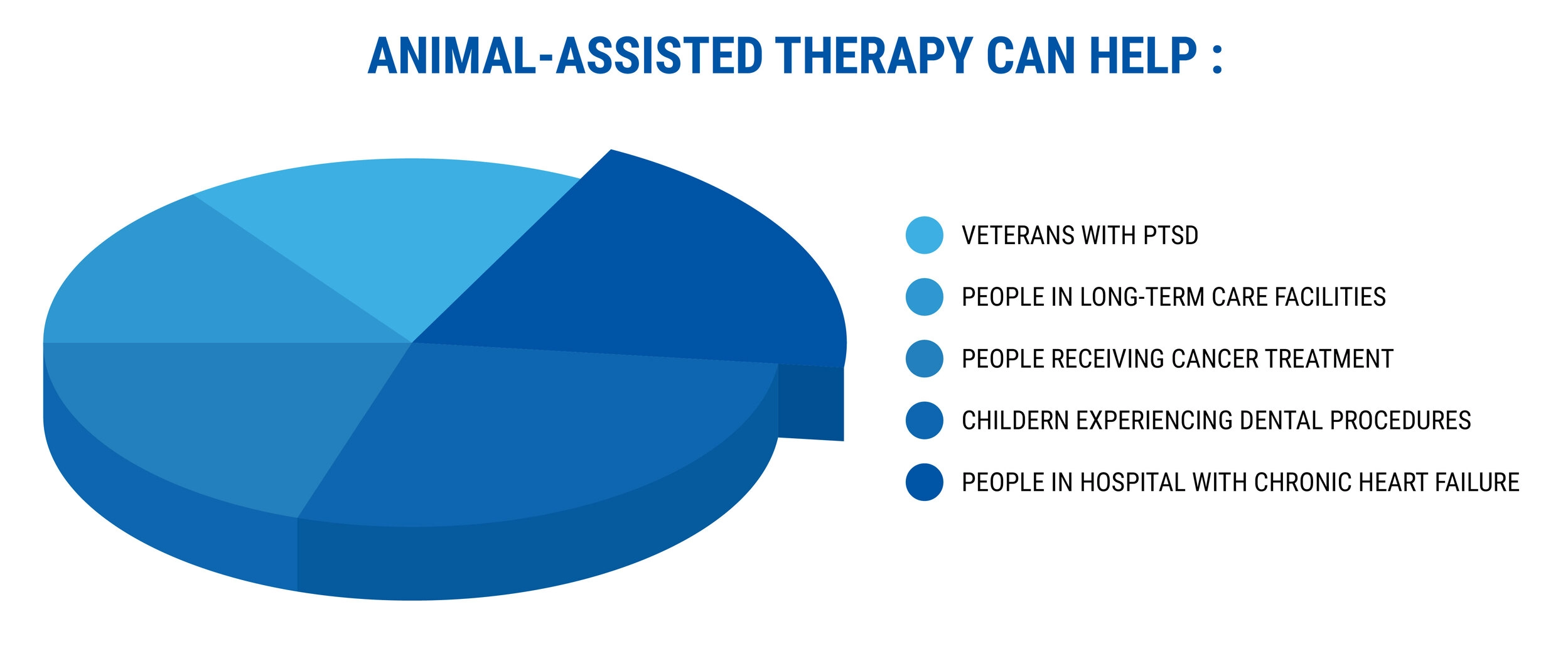
For Physical Health
Although not as common as mental health therapy, in recent years, therapy animals have been being used in physical health therapy as well.
These therapy sessions are considerably different from — and a bit more complicated than — mental health therapy sessions, but have shown to be effective.
There has not been as much research on this as much as there has on mental health therapy; however, it has been shown helpful to assist conditions like:
- Epilepsy
- Heart failure
- Pain from cancer treatment
- Postoperative recovery
- Recovery after a major stroke, or another condition that causes a person to lose motor skills
Animal-Assisted Therapy, in such cases, has the twofold effect of achieving all that mental health therapy achieves (such as relief from stress, improving mood, balancing emotions, etc.), in addition to helping physical conditions.
Physical conditions in these cases usually revolve around motivating the client to exercise and move as often as possible and assist in movement. The therapy animals are trained in a way to assist, and not be a nuisance while moving.
Additionally, many long-term care facilities for chronic diseases and illnesses offer therapy animals to be used for these “double-fold” effects.
Many times, people in such facilities need the motivation to add movement to their routine. Animal-Assisted Therapy helps switch routines up and it also helps with mood and emotional stability.

Animal-Assisted Therapy is also being extensively used in elder-care facilities. Many elderly people feel abandoned and, hence, therapy animals help them cope with depression.
A study mentions how apart from the mental health aspect, Animal-Assisted Therapy is beneficial in elderly-care facilities because a lot of the residents develop simple routines like taking the therapy animal (usually dogs) for walks, playing with them, and talking to them.
These routines help the residents feel connected with someone as well as motivate them to continue their exercise habits.
Chapter 3:
How effective is Animal-Assisted Therapy?
Animal-Assisted Therapy is considered to be an alternative and a “new-age” treatment therapy, although it was actually started much earlier than the traditional method of therapy, also known as talk therapy.
That is why Animal-Assisted Therapy is often clubbed with, and compared with, other alternative therapy methods.

In this chapter, I will explore these other options in comparison with Animal-Assisted Therapy.
Of course, each therapy method has its own benefits and shortcomings, which should be considered carefully before one chooses to pursue them.
Animal-Assisted Therapy vs. Traditional Therapy
Traditional therapy is on the rise these days, as many people have started accepting the need for it and understanding the groundbreaking benefits it has to offer.
Traditional therapy (also known as talk therapy) urges clients to talk and sort out their situations through guidance from their therapist.
The therapist’s approach can be very hands-on, depending on what the client needs. However, the crux of this type of therapy always depends on the client doing most of the talking.

This can be a bit difficult for people who are not used to sharing and reflecting upon their feelings, or people who are uncomfortable speaking socially.
Many children and adults who are on the autism spectrum can also experience difficulty with this kind of therapy, making an already existing condition much worse.
With these kinds of conditions, as well as dementia, grief, depression, and anxiety, Animal-Assisted Therapy has been shown to have greater benefits than talk therapy. A study published in Anthrozoos found that elderly people who have dementia responded better to Animal-Assisted Therapy in 11 weeks, compared to their counterparts who were on traditional therapy.
Furthermore, two studies published in the National Library of Medicine and Southern Illinois University Carbondale discuss that Animal-Assisted Therapy works much better for children and adolescents on the autism spectrum than traditional therapy, as it does not put any pressure on the client to behave in a certain predetermined way.
Also, the goals and targets set by Animal-Assisted Therapy are very different from those set during talk therapy sessions.
Parents also found that their children on the autism spectrum engage and communicate more with their surroundings while on Animal-Assisted Therapy.
Many people also found clients more willingly talking and sharing their thoughts/feelings with the animals in an organic way, after forming a bond with the animal.
This is quite normal as most animals are predisposed to provide comfort and support without any kind of judgment. Hence, clients find it easy to talk and communicate in their own way with animals rather than with a therapist.
With that being said, if talk therapy is combined with Animal-Assisted Therapy, it has been proven to show great results.
Another study published by the National Institute of Health, UK shows that when Animal-Assisted Therapy is combined with traditional therapy, it has shown good results.
The animals help the therapist to form a unique bond with their clients. Also, the animals provide reassuring comfort to the therapist and the client.
Plus, the therapist can facilitate greater conversations with the clients during sessions where animals of their liking were present.
This goes to show that Animal-Assisted Therapy can be used effectively during regular talk therapy sessions.
Animal-Assisted Therapy vs. Art Therapy
Every person has their own way of expressing themselves through various kinds of art. This is exactly the premise on which art therapy relies.
Art therapy is a new-age kind of therapy, where people are encouraged to share and express their feelings through art.
Although it is commonly conducted as an adjunct to talk therapy, art therapy has gained its own unique following in recent years.
There is not as much study and evidence-based on the effectiveness of art therapy which leads to solutions, but it is highly effective for clients to express themselves.
As art can always be subjective, it is oftentimes difficult to understand the intentions behind certain art made by clients.
So, usually, art therapy is used in small sessions where traditional therapists may ask their clients to draw/paint their feelings, and then later explain their painting.

This helps clients channel their thoughts and then be able to express them effectively. However, it can be difficult for clients who find it hard to express through talking.
Compared with Animal-Assisted Therapy, art therapy falls short as it has a lot less scientific backing to stand out on its own.
However, it is quite common to use art therapy for milder conditions for which art can be a medium of release.
Unlike art therapy, Animal-Assisted Therapy works by also forming a unique bond with the animal which is hard to replicate with art.
Another aspect of art therapy is gong and music therapy.
This kind of therapy has been used since ancient times, usually in Eastern cultures. Gong and music help calm the mind through rhythmic vibrations.
This kind of therapy is usually used with physiological conditions which are affected due to psychological trauma.
One of the most famous examples of this kind of therapy is King George VI who had a severe speech impediment.

His therapist, back in the day, used music to help him calm down. Many of their sessions were conducted where King George was made to listen to music with earphones and talk or read at the same time.
It was groundbreaking at that time since when the King listened to music, his speech impediment almost disappeared and he was able to speak fluently.
Another way in which music therapy is commonly used is with clients with a history of panic or anxiety attacks.
Certain pitches and vibrations in music and gongs are proven to relax the mind and the heart to help people overcome panic or anxiety attacks.
This kind of therapy also makes clients more autonomous, since they can control the time and type of music that helps them with their condition.
Furthermore, this therapy is also usually used as an adjunct to traditional therapy since on its own, it can fail to deliver desired benefits.
While being compared with Animal-Assisted Therapy, music and gong therapy is effective to overcome certain conditions. However, it can not be compared efficiently since it’s similar to comparing apples to oranges.
The goals, methods, and treatment plans are vastly different and utilise completely different ways to go about therapy.
Also, they target different brain parts and human needs to effectively achieve the goal. While both of them can be used as an effective adjunct to traditional therapy, it is inappropriate to compare these two.
Animal-Assisted Therapy vs. Dance and Movement Therapy
Another upcoming form of therapy is dance and movement therapy. Apart from dance, this kind of therapy also includes mild movements like yoga.
Art therapy sessions usually follow a variety of session plans. But one of the most common ones is that each session is planned around a theme.
During the session, in the first half, the client gets to express themselves through movement surrounding the theme of the session.
The second half of the session is used to express, verbally, the emotions the client felt and was expressed through their movement.

These sessions are usually accompanied by soft, soothing music and can be conducted as individual or group sessions.
The client has the liberty to use all aspects in the room and children are usually provided with various props to help them in the movement.
These sessions seek to achieve and work on the mind-body connection, as dance movement therapists believe that the mind and bodywork in tandem with each other.
And if there is a lack of function in one part, it is usually going to have an effect on the other part.
This therapy is shown to be effective for people experiencing ADD, ADHD, dementia, depression, some physical ailments, or even just to promote general wellbeing.
The restrictions to movement therapy usually occur when the client is unable or unwilling to do physical movements. In such cases, it is best to stick with other kinds of therapy.
However, this restriction usually doesn’t present itself in Animal-Assisted Therapy since there is no requirement to move. Movement is solely based on if the person is willing to move.
Chapter 4:
Turning Animal-Assisted Therapy Into a Career
The good news is that anyone with a passion for animals can become an Animal-Assisted Therapist. It doesn’t require years and years of additional medical or graduate school but, rather, requires basic training.
It is one of the best careers to pivot to and one of the most lucrative coaching businesses, to boot.

Research has shown that 49.0% of Animal-Assisted Therapists have a Bachelor’s degree, and about 10.5% of Animal-Assisted Therapists have Master’s degrees.
Even though most Animal-Assisted Therapists have a college degree, it’s possible to become one with only a high school degree or GED, as well.
Let’s get straight into the details.
Certifications Required
It doesn’t take as long to become a certified Animal-Assisted Therapist as it does for careers in other kinds of therapies.
There are however certifications that you require and also courses that you can take to get the required certifications.
Many countries require a psychologist or a psychiatrist to have formal degrees and training before they can be licensed to practice.
However, if you want to be an Animal-Assisted Therapist, it is possible to get accredited by the Veterinary Board of your country, as well as the Animal-Assisted Therapy Board. The names can vary according to your country but the general idea is that these institutes grant accreditation to those who want to legally practice Animal-Assisted Therapy.
Their certification checks if you have studied certain topics, and whether you can pass an exam to prove it (apart from showing proof of education).
Most institutes have a training/certificate program in conjunction with the licensing part.
While enrolling for such courses, you must check if their training program is accredited by the country and is legitimate.
The topics taught by such programs usually revolve around:
- Working with animals in an educational or therapeutic setting
- Correctly interpreting human and animal body language
- Training dogs and other animals to work safely in a therapy environment
- Understanding animal cognition and emotions
- Creating safe and effective programs for clients
- Anticipating and resolving potential problems
- Understanding the legal and ethical issues
- Working with a variety of personality types
- Creating animal enrichment programs
Usually, these programs can last anywhere between a year to two years, depending on whether you will be taking classes full-time or part-time. The cost is around USD 2500— USD 5000, with many universities having payment plans.
Available Courses and Renowned Program Details for Getting Certified
There are many certification programs available for individuals wishing to become involved with Animal-Assisted Therapy.
Here’s a rundown:
| Name of Institute | Certificate | Designed For | Cost |
| University of Denver | Animals & Human Health Certificate | Those with a Bachelor’s Degree or equivalent practical experience in AAT | $3,500 plus a one-time application fee of $25 for registration |
| Animal Behavior Institute | Certificate program in Animal-Assisted Therapy conducted online | Therapists, social workers, educators, and healthcare workers. | $5,925 plus the cost of textbooks or other class materials |
| Animal-Assisted Therapy Programs of Colorado | A Certificate in Animal-Assisted Psychotherapy (CAAP). | Mental health professionals and students with an interest in animal-assisted interventions. Applicants must be students or have earned an advanced degree in the mental health field. | $2, 100 |
| Oakland University (Michigan) | A distance-learning Animal-Assisted Therapy program. | – | $2,495 |
| Harcum College (Pennsylvania) | A distance-learning Certificate course in Animal-Assisted Therapy | No specific degree or training is required. | $1,065 |
- The University of Denver (in Colorado) offers an Animals & Human Health certificate that requires one on-campus course and three online courses.
Designed for: Those who have a Bachelor’s degree or equivalent practical experience in animal-assisted therapy.
The on-campus course is the capstone, which involves student presentations, group work, and interaction with animal therapy professionals.
Program cost: $3,500 plus a one-time application fee of $25 for registration (lodging and travel costs for the campus portion are not included).
The program fee can be paid as a lump sum or in installments.
- The Animal Behavior Institute offers a Certificate program in Animal-Assisted Therapy that is conducted entirely online.
Designed for: Those working as therapists, social workers, educators, and healthcare workers.
The program involves five courses that take 10 weeks each to complete. The program also requires 40 hours of experience in the field as an intern, employee, or volunteer at an approved institution.
Students may receive transfer credit for similar coursework completed elsewhere.
Program cost: $5,925 plus the cost of textbooks or other class materials.
- Animal-Assisted Therapy Programs of Colorado offers a Certificate in Animal-Assisted Psychotherapy (CAAP).
Designed for: Mental health professionals and students with an interest in animal-assisted interventions. Applicants must be students or have earned an advanced degree in the mental health field.
The certificate program includes six online courses, which can be completed at the student’s own pace.
The program also offers a virtual classroom allowing students to network. The course is eligible for continuing education credit hours.
Program cost: $2,100.
- Oakland University (in Michigan) offers a distance-learning Animal-Assisted Therapy program.
The program is conducted online and involves five modules each with five consecutive weeks of study.
Students are required to write a full animal therapy business plan at the conclusion of the program, which includes five courses.
Program cost: $2,495.
- Harcum College (in Pennsylvania) offers a distance-learning Certificate course in Animal-Assisted Therapy.
The 10-week program is completed at the student’s own pace and includes reading assignments, discussions, essays, and two site visits to organizations in their community that utilize animal-assisted therapy.
The course may provide continuing education credits or help a candidate expand their work in psychology, healthcare, or rehabilitation.
Participants are not required to have a specific degree or prior training.
Program cost: $1,065.
How much do Animal-Assisted Therapists make?
So now that we know how and where to get certifications for becoming Animal-Assisted Therapists, let’s talk about the numbers.
The US Bureau of Labour Statistics found that AA therapists working with an organization make a minimum of around $19/hour; that’s a little less than $50,000 a year!
Plus, get this — in the next 10 years, this career is going to witness a growth of approximately 28%!
But, of course, there is no ceiling to this vocation.
A well structured Animal-Assisted Therapist business can have very high earning potential
Where can Animal-Assisted Therapists get a job?
If you feel that you are unsure about jumping into starting a coaching practice, it is possible to get experience by working in jobs related to Animal-Assisted Therapy.
Types of Jobs Available
Most of the jobs available for Animal-Assisted Therapists are either as accompanying therapists, assistant therapists, or animal handlers.
These kinds of jobs are available in hospitals or mental health facilities, apart from other niche places. It is also easy to find jobs in nursing homes or old-age homes.
Many times, in these kinds of jobs, you can be hired as an independent consultant who comes for visits during set time periods.
This can help you set your own client base, as well as retain the free time to do other things.
Comparison of Sectors for Animal-Assisted Therapists
While working with organizations ensures that you have stable pay, it might not necessarily always be attractive pay.
Many organizations find it difficult to assess an Animal-Assisted Therapist’s worth, and, thus, end up underpaying them.
It is common for Animal-Assisted Therapists to have to convince their organizations about their worth, especially because many organizations just don’t understand how to categorize them in their employment plans.
This is thankfully changing, as people are slowly starting to understand the importance of Animal-Assisted Therapists, but we still have a long way to go.
I suggest, instead, starting to think about setting up a practice and coaching business, of your own.
It may initially have some overheads, like finding space for the sessions, as well as appropriate housing for the animals; but once that is set up, you are good to go.
It’s also worth mentioning that having a coaching business puts you in charge of your own hours, and gives you the full liberty to practice therapy as you may like. It will also allow you to charge for your worth and cater to the niche you prefer.
An Animal-Assisted Therapist coaching business can be a very lucrative and rewarding one.
You can read about how rewarding it has been for other Animal-Assisted coaches in our case studies.
Professional Groups to Join
There are several professional groups you can join to find clients as well as to keep in touch with the developments in the field.
These groups can help you become a member of various associations and develop your own brand, as well. Many of these groups include veterinarians who can also give you important guidance.
Some of these groups are:
- Equine Assisted Growth and Learning Association (EAGALA)
- National Center for Equine Facilitated Therapy (NCEFT)
- Pet Partners (formerly Delta Society)
- Therapy Dogs International
The first two organizations are dedicated to professionals who use horses as part of their therapy work, while Pet Partners is more general. Therapy Dogs International, as the name would suggest, caters to therapists working with canines.
Annual fees vary by organization. Consult the website of the organizations that interest you to download application materials.
There may also be other Animal-Assisted Therapy organisations and groups in various countries which you can join to get more information.
How to Find Clients
That finally brings us to the most important question that might be on your mind —
how do you find clients?

There are a few basic ways to make sure you are attracting the correct clients for your business.
They are:
- Building an attractive website — the importance of a website cannot be overstated.
- Establishing a prominent and memorable social media presence.
- Contact other members of your professional groups to find out about job openings or any clients they wish to pass on with a reference.
- Contact other professionals and friends in the Animal-Assisted Therapy community to let them know that you are up for referrals.
- Contacting and building a rapport with other psychologists, mental health professionals, nursing homes, elderly care homes, etc. to pitch your services.
- Attending Animal-Assisted Therapy conferences to network.
- Talking to friends and family about your new venture.
Let’s now take a look at how to find the correct therapy animal for clients.
Chapter 5:
Finding the Correct Therapy Animal for Clients
The most commonly used animals in Animal-Assisted Therapy have been dogs, horses, and cats but lately, many other animals are also being incorporated as therapy animals, based on the varied needs of people.
With practices such as goat yoga and cow cuddling, people are realising that almost all domesticated animals are capable, in various ways, of providing support and comfort to humans.

So, how can you, as a licensed Animal-Assisted Therapist, find and recommend the best-suited therapy animal for your client?
Let’s unravel this question in this segment so that you are well-equipped to embark upon this career path.
Types of Animals Used for Animal-Assisted Therapy
The best part about Animal-Assisted Therapy is that there aren’t any restrictions for the kind of animal that can be used for therapy, as long as the animal passes the requirements and certifications listed below. This allows for the therapist and the client to work together in finding a therapy animal that best fits the needs and goals of the client.
Some of the most common therapy animals include dogs, horses, cats, dolphins, fish, birds, and small rodents. But the size, breed, and type of animal is selected only after carefully considering all the possible options and comfort levels of the client with each type of animal.
While the usage of dogs, cats, and horses as therapy animals is backed with extensive research, the treatment with other animals, such as dolphins, has shown mixed results and warrants more research.
However, if the animal helps in achieving the desired goals and is not detrimental to the expected therapeutic benefits, it can be used.

Many therapists have adapted their practices to include therapy animals in creative ways, especially when treating young children, and children with autism.
One such way is to have a petting zoo where the children can interact and pet different animals during therapy, as long as the animals are all tested and approved for therapy.
Pet zoos have shown incredible therapeutic benefits and are now being incorporated in a lot of children’s hospitals all across the world.
It is, however, important to make sure that along with the therapist in charge, the handlers of all the different animals are present during each such therapy session.
Another technique adopted by professionals is one where clients live at a nature camp for an extended period of time. This technique is usually geared towards teenagers and adults.
In this treatment, a rich and immersive experience of living in nature augments the therapy and the training being provided to the clients. This technique is gaining more popularity within the elderly community, who desire a lifestyle closer to nature.
There are also shorter duration camps, such as grief camps, which are designed especially for those children and adults who are dealing with the loss of a loved one.
Usually, at such camps, horses and dogs are used extensively for the therapy sessions due to their ease of handling and also because they have a proven track record in helping clients cope with bereavement.
Oftentimes, dogs and other therapy animals are also allowed to sleep with the person in therapy at such camps, as long as it is approved by their handler and the therapist.
But it is important to bear in mind that not all pets can be considered therapy animals, and vice versa. Pets are usually neither trained nor certified for therapy.
Requirements for the Animal Used in Animal-Assisted Therapy
Before finalising the animal, it is necessary to check whether the animal to be used for Animal-Assisted Therapy meets all the different requirements.
Naturally, these requirements may vary a little bit according to the animal you have chosen, but the following set of guidelines constitute the preliminary groundwork.
Let’s look at what these requirements are:
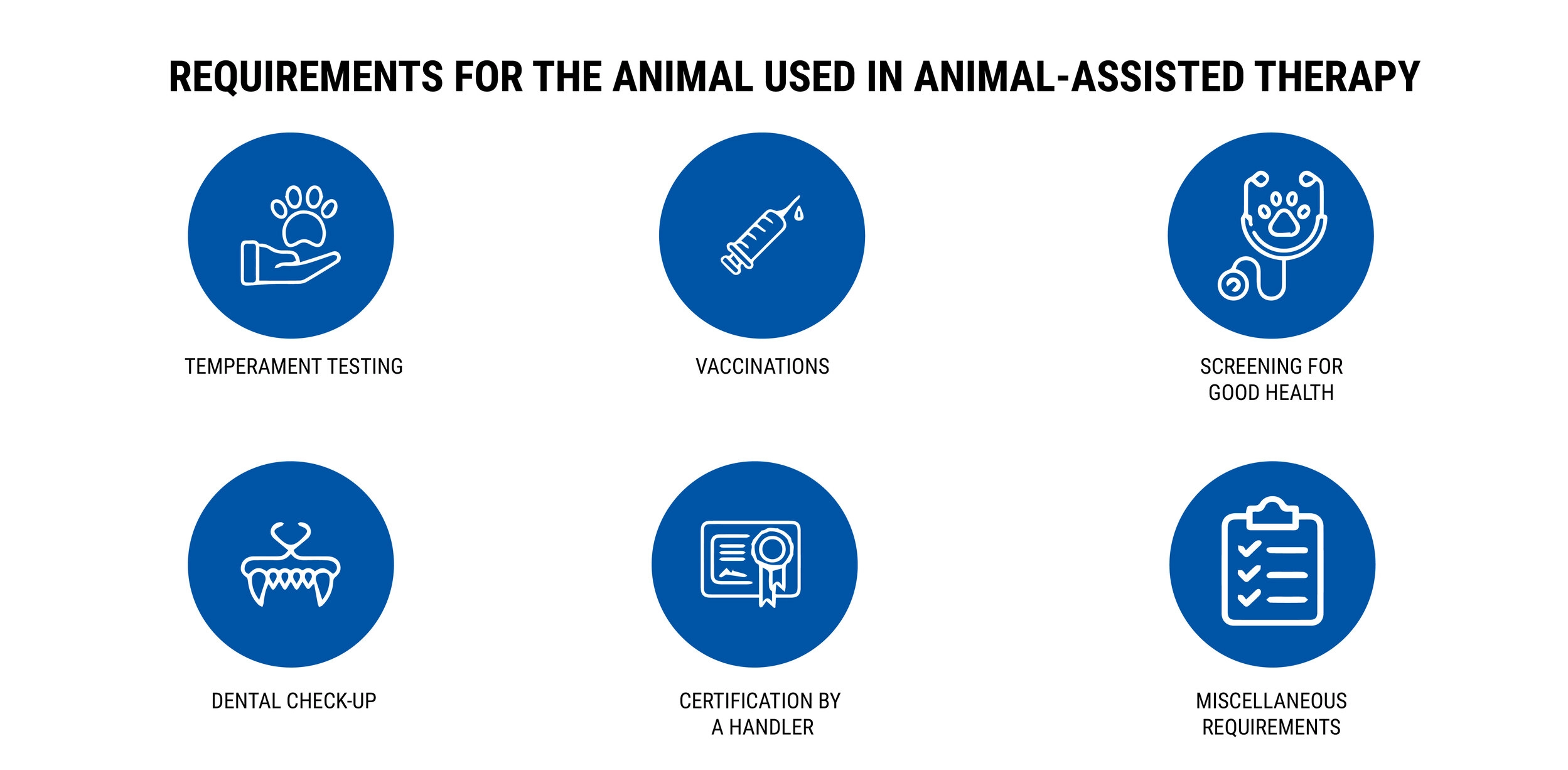
Getting the Animal Temperament Tested
Temperament is an animal’s specific predisposed behavior. It changes according to the type and the breed of the animal.
For example, dogs, labradors, and golden retrievers are usually believed to have a calm and composed temperament, suitable for their use as therapy animals. Whereas chihuahuas or Pomeranians, on the other hand, might be considered as having an unreliable temperament.
Temperament testing tells us which animal type and/or breed is more prone to attacking or behaving very aggressively if touched or put under conditions that it might consider dangerous.
There are certain tests certified Animal-Assisted Therapists and veterinarians conduct certain tests together to determine whether a dog’s temperament is suitable to be used as a therapy animal. The same method of testing is used for other animals like cats and horses, too
The bottom line is that the animal, regardless of type, needs to be friendly and adaptive. It needs to also like human contact and feel good while being petted. No animal is legally allowed to be called or used as a therapy animal without being temperament tested.
What is the difference between temperament and training?
Temperament and training should not be confused. While a good standing in both is absolutely necessary while selecting a therapy animal, they can be confusing to understand.
Temperament is the animals’ natural instinct and behaviour. This is the natural way in which the animal will behave in various situations, especially in situations causing threat or stress to the animals.
This can be considered as the “nature” part of this discussion.
So, then, training can be considered as the “nurture” part.
Training is basically teaching the animal to be obedient and follow commands given by its trainer during therapy. So, in essence, training is the behaviour of the animal that can be taught and controlled.
Therapy animals must go through several sessions of training with a licensed trainer who works with animals to teach them how to react, behave, and guide several situations that the animal might encounter in therapy. Furthermore, training is what makes the animal licensed to be used as a therapy animal.
For successful therapy sessions, the animal used for therapy must have a good combination of both.
Why should therapy animals be temperament tested?
Apart from the obvious answer that animals cannot be used for therapy purposes without being temperament tested, temperament testing is necessary to understand the character of the animal.
It is a crucial step in recognising whether the animal will be a good companion or not.
Furthermore, it also helps to decide how to use the animal’s behaviour for maximum effect during therapy. Temperament testing is also a good way to predict how the animal will respond during times of stress.
Knowing this can help the therapist to be prepared for all kinds of situations, thus ensuring the safety of the client and the animal at all times.
Getting the Animal’s Vaccinations in Order
This is a no-brainer. The animal has to be vaccinated regularly against all kinds of diseases and ailments, especially rabies, to make sure they are safe in case of any incident.
Getting the Animal Screened for Good Health
This type of testing can be done with any authorized veterinarian who would check the animal’s overall health and wellbeing.
The test will make sure that they are free of any ailments which can potentially hamper therapy. It will also screen them for any predisposing factors such as skin conditions, etc. because the animal needs to have “good skin, and coat of hair” which is free of potential illnesses or allergies.
Getting the Animal’s Dentals Checked
Another important aspect is to get the animal’s teeth and dental records checked.
Although it may sound a bit funny, it is important to do it since healthy gums and teeth are a sign of good health.
Also, the teeth and the face are sometimes what comes the closest to the client, so one needs to make sure they are hygienic and healthy.
Having Handling Certified by a Tester/Handler
The animal will have to undergo 2-4 sessions with a handler and a tester, who will rate the animal on its ability to behave and take commands.
They will also check for good manners, behaviour, and how well you are able to handle the animal as a therapist.
After these sessions, you will be required to complete 2-3 more sessions where the animal will be visiting various care facilities, and the trainer/handler will judge the animals’ responses.
After this, all you have to do is apply and get a certificate!
Other Miscellaneous Requirements
- The animal needs to be more than a year old and possibly neutered.
- This is where more specific tests may come in, depending on the kind of animal you wish to use for therapy.
- It’s also worth noting that most pets already have these certifications and requirements in place, so this part of the process generally doesn’t take very long.
- As a safety guidance, it is always requested to avoid using snakes and other serpents as a part of therapy, as they may not always be suitable and can possess unknown threats.
How to get therapy animals?
Now that you know all the factors which will help you in choosing the right animal, let’s figure out how to get these animals.
In many instances, the therapy animal is a pet of the client. This way, things are a lot easier, since you, as a therapist, don’t have to spend time finding and training the animal.
However, many therapists prefer having animals of their liking. This way they can choose whether to offer Animal-Assisted Therapy with dogs, cats, or horses, for example. Once a decision has been made on the type of animal, the next step is to either adopt or buy a few of these animals, as preferred.
This is one of the most interesting and exciting parts of being a therapist since you get to be hands-on and interact with the animals during their training as well as a testing period.
Plus, you get the chance to understand each of your therapy animals individually, thus, forming unique bonds with them. This aspect, in particular, can help you better assign them to your clients.
Since the ultimate choice of animal lies with you as a therapist, it can be confusing. We recommend you to stick with one type of animal, as it is easier to handle and work with.
Apart from this, it is also possible to hire animal handlers, who bring their own therapy-trained animals to sessions.
This can, undoubtedly, add to your expenses and also increase dependency on the handler while conducting the sessions, but it can be a great way to keep the costs of establishing your team of therapy animals down in the long run.
Chapter 6:
How to Be a Standout Therapist
To be an extraordinary therapist, you need to be able to tailor your sessions to fit the needs of each client.
Therapy, in any form, is not a one-size-fits-all model and, therefore, requires modifications and changes as per the needs of the client.
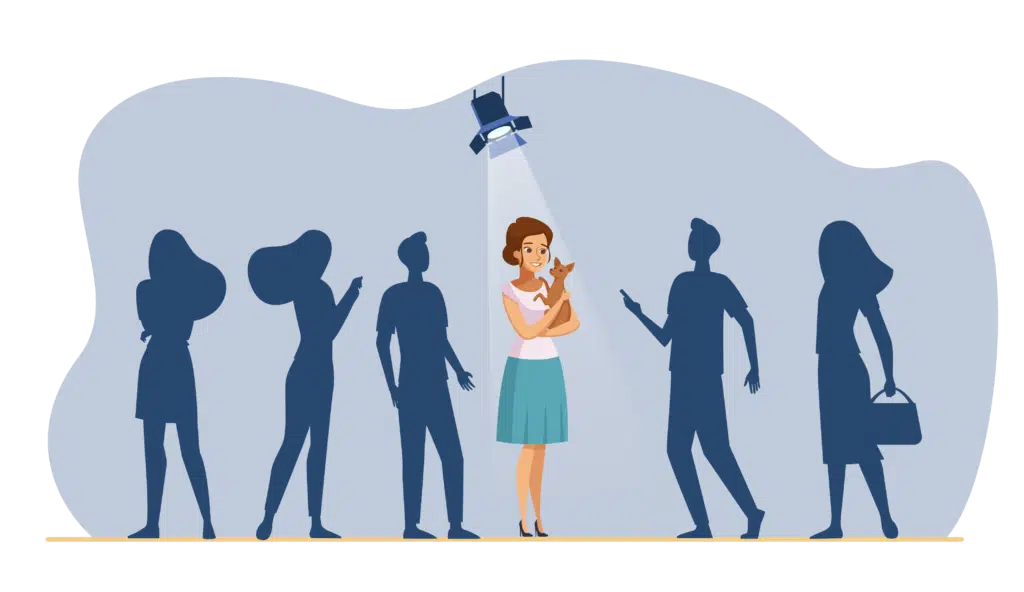
Animal-Assisted Therapists also have the added responsibility of adapting their animals to the demands of their various clients individually.
So how can therapists modify and adapt their practice from one client to another?
Read on to find out more.
Adapting to Each Client
This is one of those skills which can easily set you apart from your competitors if done right.
Many therapists take a one-size-fits-all approach to therapy, which is not advisable.
Each client’s needs are unique and must be addressed personally because what works for some people, may not always work for others.
It boils down to caring and paying individual attention to your clients and their needs.
Similarly, when it comes to choosing an animal, you must not impose your choice on your client. For example, if someone doesn’t like dogs, it’s far better to use a different animal than trying to have the client adapt to the dog.
Furthermore, just like it is important to give your client the space to form a connection with the animal, it is equally important for you, as the therapist, to form individual connections with all your clients.
Adapting to Circumstances
Apart from adapting the therapy to the needs of the client, it is also important to adapt to changing situations.
This past year has been a testimony for the same.
None of us predicted a pandemic of this scale and, obviously, it has affected therapists and clients to a great extent.
Clients who were used to attending therapy mainly dependent on physical touch were suddenly forced to stay at home.
So how did some Animal-Assisted Therapists adapt to this? And what skills can they develop to continue effective therapy in such times?
A great example has been set by Animal Angels Foundation (AAF) from India.
They typically use an eclectic mix of Indian breeds, labradors, golden retrievers, a cocker spaniel, and a beagle, all aged between 2-7 years.
On a weekly basis, they visit about 50 children and 25 adults across 12 special schools, 10 private homes, a mental health center, and a hospital.
But this was brought to a halt when the pandemic hit, and all these sessions had to be shifted online.
It was quite cumbersome, to say the least. Since physical interactions with the animals are essential to Animal-Assisted Therapy, many children started experiencing anxiety, restlessness, and disturbed behavior in its absence.
However, the therapists managed to move the dogs’ sessions online rather quickly as all the dogs had to follow the commands from their trainer.
“Virtual sessions don’t make much of a difference to the canines because they are taking cues from the therapist /facilitator,” said the therapists who had been working online to keep Animal-Assisted Therapy sessions running. “All they have to do is sit in front of a screen and we have to manipulate their behaviour, so the clients feel that the dog is listening and responding to them. The animals per se don’t respond to a screen, and don’t know where the sound is coming from if the client calls out to them.”
But it was still challenging to keep children engaged online.
Furthermore, not all parents or older clients are able to afford digital devices for therapy sessions. In such cases, AAF raised funds to provide as many distressed families with digital devices as possible to help continue the sessions.
Therapists say that they have done the unimaginable like setting up fundraisers, conducting sessions at odd hours, etc. to continue sessions online but still learned from the process and found ways to be of benefit to clients.
They recommend always having an open mind and trying as many creative ways as possible to keep ahead of any unforeseen events.
Incorporating Animals in the Therapy Process
When people choose Animal-Assisted Therapy, they come with a prior understanding that they need to interact with animals.
So, it’s likely that most of them love animals and being around them.
But that doesn’t mean they love all animals of all temperaments.
Hence, it is important to properly communicate the likes and dislikes of your clients before choosing a therapy animal for them.
Many times the clients will themselves tell you which animal they want and prefer, but this might not always be the case.
It may happen that the client changes their preference of the therapy animal after a few sessions.
To avoid such scenarios, it is essential to establish clear communication from the beginning and avoid such occurrences in the later stages of therapy.
So, one of the first things a therapist has to do is to help their client choose a therapy animal if they don’t already have one. It’s best to choose an animal of the client’s preference for therapy as long as the animal is not dangerous and is trained to be an AA therapy animal.
Chapter 7:
Limitations of Animal-Assisted Therapy
Animal-Assisted Therapy is a great alternative to traditional therapy and is also a great way to establish a secure salary.
It is helpful and can be customized to fit the needs of diverse clients.
However, it is important to understand the concerns that can come up while you are practicing this vocation.
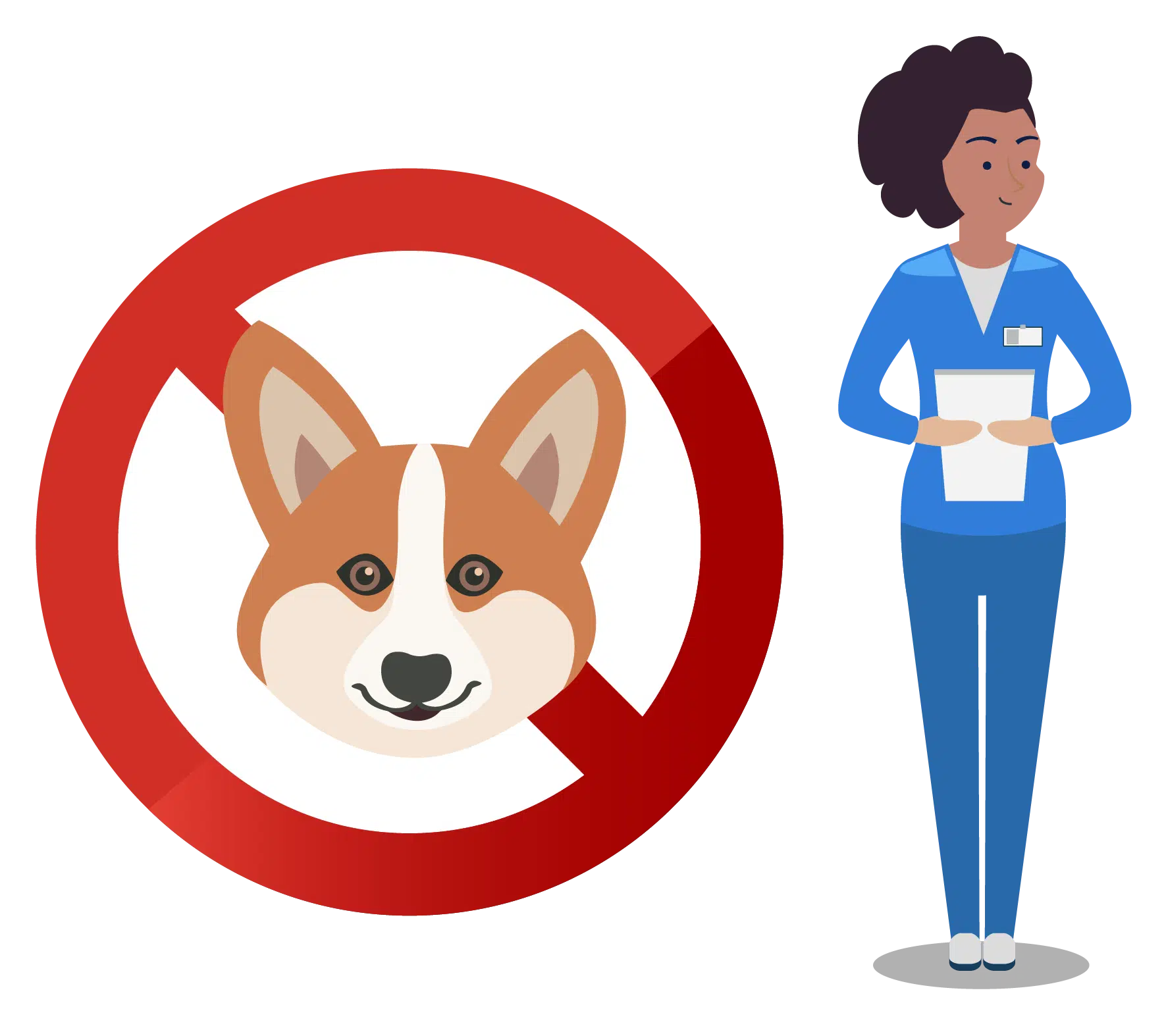
Ethical Concerns
While working with animals, the most important thing to remember is that at the end of the day they are also living beings, with feelings and emotions.
They need care and love. It can be especially tiring for animals to have the day packed with sessions and it may affect their mental health.
Moreover, therapists can sometimes overlook the fatigue experienced by their animal counterparts.
As Animal-Assisted Therapy keeps growing, it is imperative to develop formal training guidelines and practices, which the therapists must follow to ensure the well-being and safety of clients as well as the animal.
There should be a better understanding of how long an animal can be a therapy animal before starting to bear the brunt of it all.
Additionally, therapists must continue researching the human-animal bond and conduct in-depth and measurable studies examining the therapeutic benefits of Animal-Assisted Therapy across different populations and settings.
Risks
The biggest risk of working with animals is that, however well behaved they may be, they are usually driven by instinct.
Although trained, therapy animals will hardly do anything intentionally to harm a human, but sometimes, accidents may happen.
This risk cannot be completely mitigated but the easiest way to avoid it is to regularly get the therapy animal temperament tested and set boundaries with clients regarding their behaviour with the therapy animal.
Another big risk is if the clients develop an allergy to their therapy animals and find out when it’s too late. It is therefore advisable to ask your clients to get allergy-tested before confirming the Animal-Assisted Therapy.
Sometimes, an over-attachment to the therapy animal can cause the client to feel a sense of ownership over it, which may not be healthy. If such a situation occurs, it’s best to address it with the client and slowly decrease the amount of time the client sees and interacts with their therapy animal.
Lastly, some therapy animals are routine visitors to elderly care facilities and other facilities, which may have clients with contagious diseases.
It may happen that the animal’s coat becomes a carrier of these diseases.
Hence, it’s of utmost importance to keep the therapy animal clean and hygienic at all times and possibly give them baths regularly.
Liability Insurance Coverage
One of the most important aspects of starting an Animal-Assisted Therapy business is to make sure that you have liability insurance.
Without a doubt, training the animal correctly to avoid any mishaps is crucial, but it is always advisable to have liability insurance just in case.
I know a story of an Animal-Assisted Therapist who works with horses and got sued, when one of his horses, unfortunately, stepped on the client’s foot and broke their toe by mistake.
The client sued the therapist for negligence for $100,000.
Another therapist got sued when a client’s car was scratched by the therapy dog’s collar by mistake.
So, unforeseen incidents like these are common. Hence, it is always advisable to have insurance to cover all bases.
There are a few main types of insurance an AA therapist must have:
- General Liability Insurance
General liability covers basic Animal-Assisted Therapy risks, such as client property damage and injuries.
Bundle with property insurance for savings in a business owner’s policy.
This best covers :
- Slip and fall accidents
- Damaged client property
- Libel or slander lawsuits
- Business Owners Policy (BOP)
A BOP bundles property insurance and general liability insurance at a discount.
It’s often the most cost-effective type of commercial insurance for Animal-Assisted Therapists.
This best covers:
- Client injuries
- Damaged business properties
- Business interruption incidents
- Workers Compensation Insurance
This policy is required in many countries for pet-assisted therapy businesses with employees.
It can cover medical costs for work-related injuries.
This covers:
- Employee medical expenses
- Missed wages
- Legal costs
- Professional Liability Insurance
This policy can help cover legal expenses if an Animal-Assisted Therapist is sued for work mistakes, such as a client injury from interaction with a therapy dog or horse.
This insurance includes:
- Accusations of negligence
- Client injury from animal interactions
- Therapy mistakes or oversights
See which of these your country or state provides, and then choose what fits your business type the best.
The most important one I recommend is Professional Liability Insurance, as it covers all bases.
Cost Breakdown of Necessary Investments
While being an Animal-Assisted Therapist is an attractive career opportunity, there are a couple of costs that need to be considered.
I’ve outlined below a list of costs that one may encounter while setting up this business. However, it is crucial to know that this list may not be all-inclusive and can vary slightly depending on where you wish to set up your AAT business.
- Costs related to maintaining the therapy animals
One of the basic costs that Animal-Assisted Therapists encounter is the cost to maintain the therapy animal chosen.
This cost can be further broken down into few specific costs such as:
- Cost of feeding the therapy animal
- Vaccination costs of therapy animals
- Veterinary visits
- Capital investment of buying and building a place for animals to stay
- Yearly registration costs of therapy animals
- Costs of certifying a therapy animal
- Miscellaneous costs
- Costs of joining and maintaining membership of professional therapists groups and communities
- Insurance costs
- Certification costs to become a registered Animal-Assisted Therapist
- Rent or mortgage payments of your (i.e. the therapist’s) office
- Miscellaneous costs
These costs can seem daunting at first, but you need to remember that being an Animal-Assisted Therapist is one of the easiest and most rewarding ways to a lucrative and gratifying career.
You can read the rewarding stories of some of our clients to gain an understanding of how fulfilling a career as an Animal-Assisted Therapist can be.
Chapter 8:
Case Studies
Well now you may be thinking, “Okay, I have all the information I need to become an amazing Animal-Assisted Therapist now, but are there others like me who are already successful?”
“And if yes, how successful?”
Don’t worry, we got you covered. Below are a few examples of clients whom we helped in setting up their Animal-Assisted Therapy business, who are consistently hitting it out of the park; month after month, year after year.
They were able to turn their passion for animals into a stellar business and are now extremely happy with the results.
Read on to find out more about these people and their stories.

Lissa Pohl
Lissa has always been a very sensitive person who understands others and their needs like no other.
She has worked on herself and understood her emotions since a young age. And that helped her to bring forth groundbreaking changes in her clients through experiential learning.
She believes, “The times in which we live are becoming increasingly complex. Our rational mind (IQ) can be overstimulated, misinformed, and disconnected from our emotional (EQ) and physical intelligence (PQ). This lack of alignment on all levels can create confusion, lack of clarity and challenges that lead to disengagement at the organizational level.”
Realizing that these experiences are not unique, Lisa pursued, both academically and as a practitioner, experiential learning methodologies that support leaders in developing the perceptual skill set that allows them to integrate IQ, EQ, and PQ to increase their Engagement Quotient (EnQ).
She was able to invent two highly powerful methods of experiential learning for teams through her Lights-On Leadership and Equine-assisted Learning (EAL) practices.
She has found a stellar way to combine the intelligence with which horses help human interaction with experiential learning.
She says, “Experiencing these somatic ways of engaging others have been game-changing for my clients. This extra-sensory way of learning is the ‘missing link’ in most other transformational leadership development and engagement programs”.
We became a part of her journey from the very beginning and helped her to bring this special education out in the world and become a successful entrepreneur.
Her clients include big brand names who have seen transformational changes in their team and employee habits after attending her equine-assisted self-development programs.
She has been able to turn company behaviour around to create more successful and motivated employees, and she swears by horses’ ability to help humans understand and utilize team dynamics in the best way possible.
Paul Hunting
From a very young age, Paul was passionate about horses and felt a unique connection with them.
Whenever he was experiencing emotional turbulence, being around horses would help him calm down and channel his feelings in the right direction.
But when the day-to-day responsibilities of his adulthood took over his life, he started to spend less and less time with horses. Over the course of time, he realized that he was not happy doing a mundane job and decided to quit. He set out to establish a coaching business in the 1980’s, when no one had even heard of coaching.
He channeled his inner creativity and drive to build a coaching business that helped people with personal development and autonomy.
However, due to the tragic recession in the 1990’s, Paul had to shut shop. This sudden blow made him remember all the good times he had spent with horses, and he decided to pay them a visit.
While he was there, he had a unique idea — what if he were to combine what he had learned from being with horses with his coaching skills?
He soon realised that horses were extremely capable of understanding human emotions and could help humans navigate through turbulent times.
Through years of trial and error, as well as with our guidance, he was able to find the perfect, empirically proven method to use horses as therapy animals for people who are finding their life’s passion and purpose.
Not only did he use horses to help people build leadership skills, he also helped them gain full control of their life in terms of time and money.
He is already a six-figure generating coach who has helped other people establish six-figure businesses through his unique method.
Sandra Dee Robinson
Another one of our clients is known to many as an exceptional actress and a superstar.
Sandra has always set the example of being the best in her field — whether it be acting, or something else.
She has been actively involved with us since the beginning of her coaching journey, and currently has a well-established coaching business. She uses horses to help people lead a stress-free life.
She also incorporates elements of nature and well-being to make her clients’ mental health better and fully nourished.
Her clients have had the experience of coming out of therapy with improved mental health as well as various leadership and life skills.
Conclusion
Setting up a rewarding business as an Animal-Assisted Therapist is fairly straightforward and easy, especially if you closely follow the guidelines and fundamentals I have outlined for you above.
This kind of therapy is already picking up in all parts of the world and will only continue to grow.
In the near future, more empirical studies are expected to be conducted on this subject, yielding more concrete results to help create best practices in the field.
Also, this will raise more awareness with the larger public about Animal-Assisted Therapy’s benefits to humans as well as prompt them to reach out to more AA therapists. It’s only upward from here!
Frequently Asked Questions (FAQs)
What is an animal assisted therapist?
Animal-Assisted Therapists use animals, sometimes even pets, for therapy.
How much do animal assisted therapists make?
The salaries of Animal Assisted Therapists in the US range from $32,360 to $93,100 , with a median salary of $56,010.
How do i get certified for animal assisted therapy?
It doesn’t take as long to become a certified Animal-Assisted Therapist as it does for careers in other kinds of therapies. There are however certifications that you require and also courses that you can take to get the required certifications. Many countries require a psychologist or a psychiatrist to have formal degrees and training before they can be licensed to practice.
How do I become an animal therapist?
If you want to be an Animal-Assisted Therapist, it is possible to get accredited by the Veterinary Board of your country, as well as the Animal-Assisted Therapy Board. The names can vary according to your country but the general idea is that these institutes grant accreditation to those who want to legally practice Animal-Assisted Therapy.
Do therapy animals have to be certified?
Most institutes have a training/certificate program in conjunction with the licensing part. While enrolling for such courses, you must check if their training program is accredited by the country and is legitimate.

Download a FREE PDF version of this guide…
PDF version contains all of the content and resources found in the above guide.
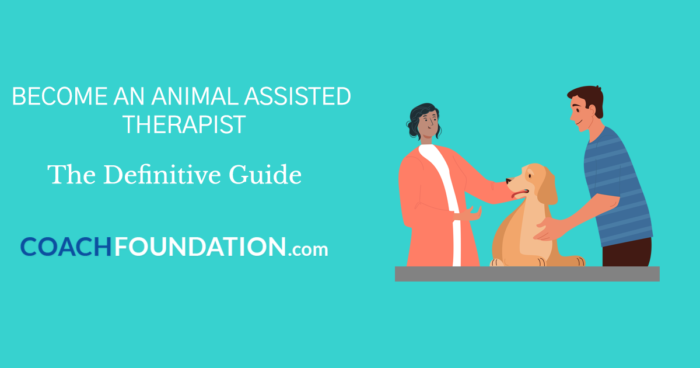


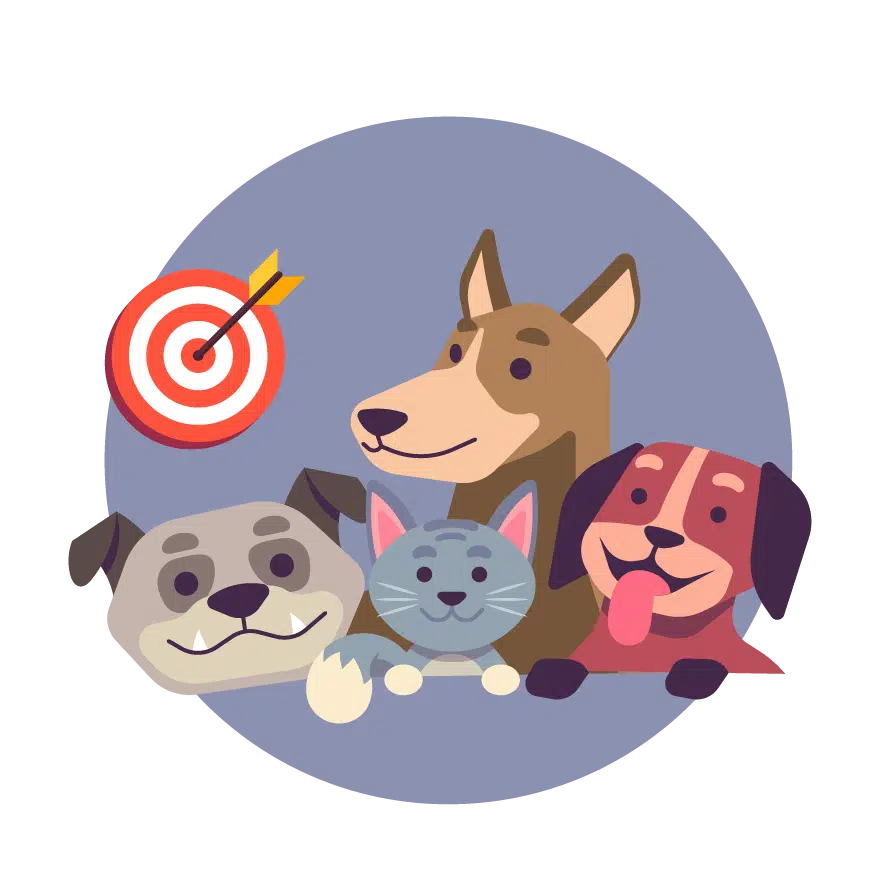



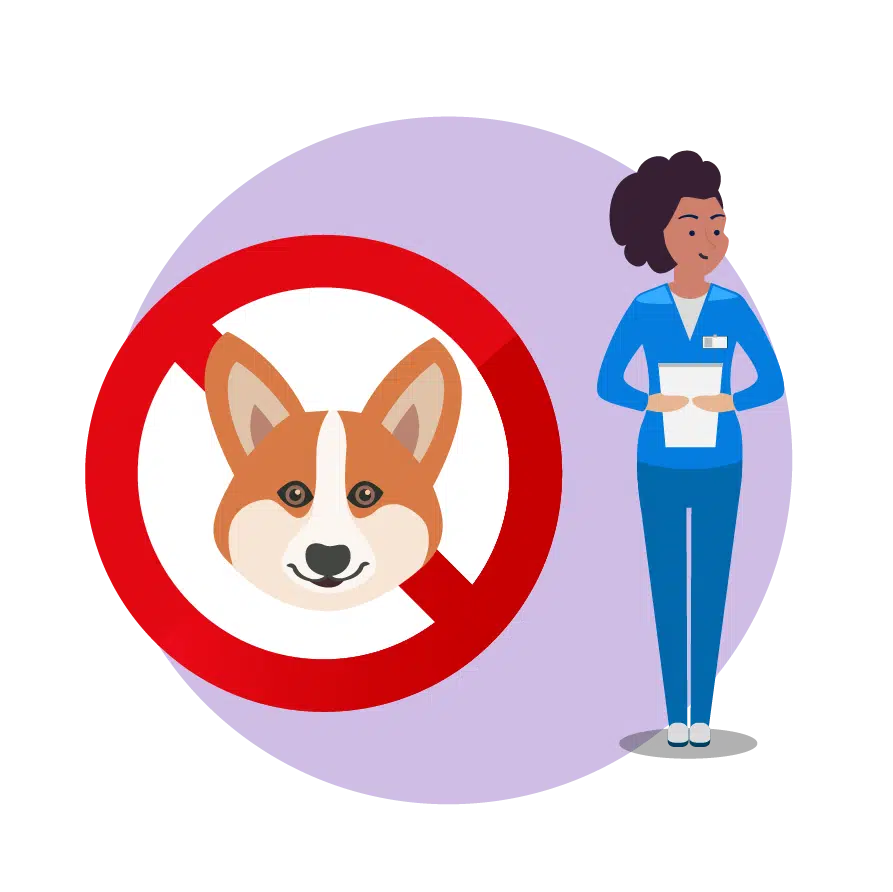





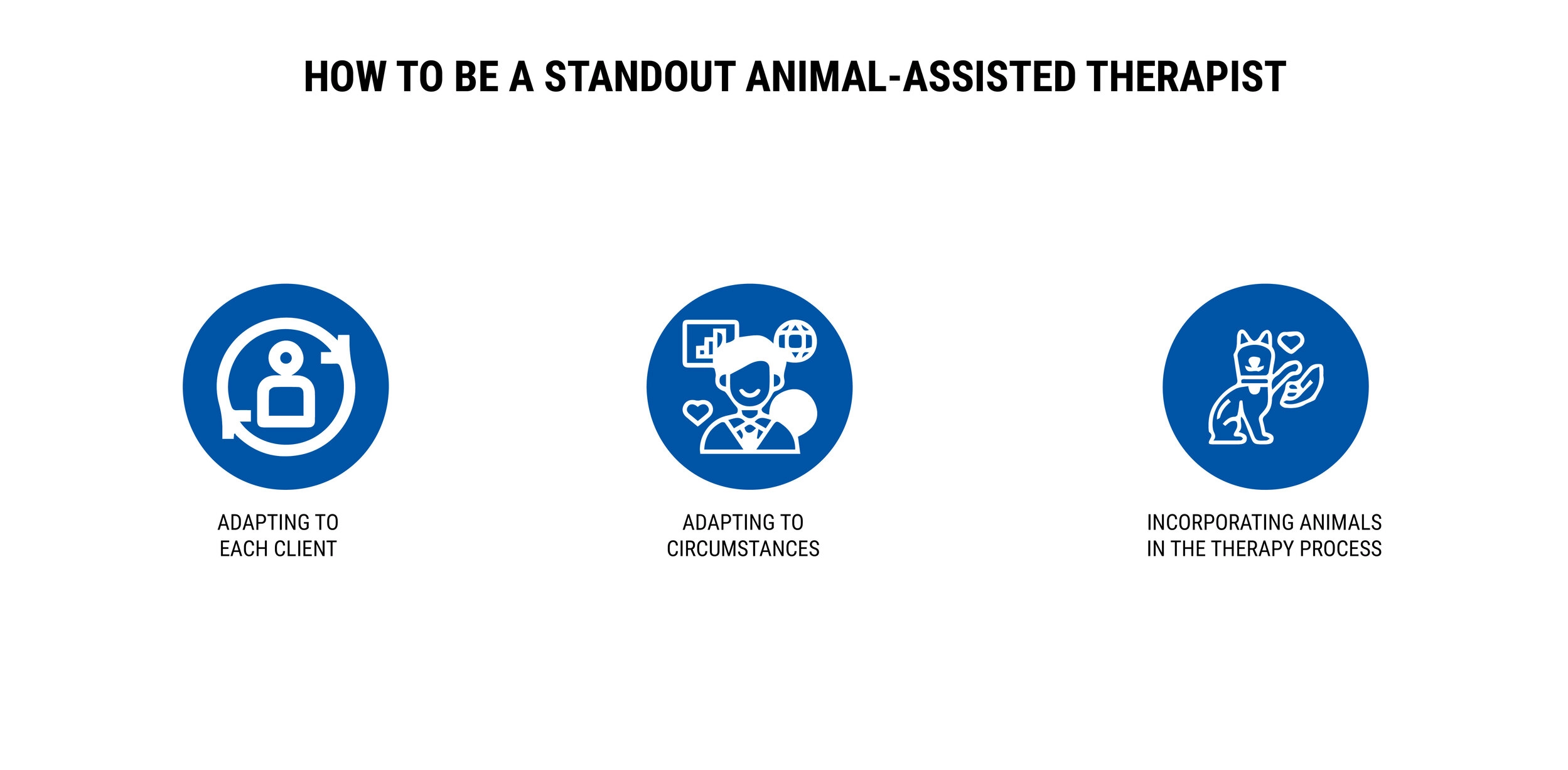




ABOUT SAI BLACKBYRN
I’m Sai Blackbyrn, better known as “The Coach’s Mentor.” I help Coaches like you establish their business online. My system is simple: close more clients at higher fees. You can take advantage of technology, and use it as a catalyst to grow your coaching business in a matter of weeks; not months, not years. It’s easier than you think.
AS SEEN ON
0 Comment